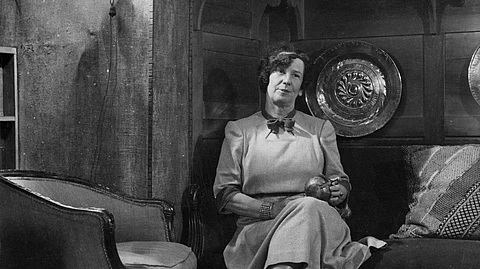
- Destinations
- Experiences
- Stay
- What's new
- Celebrating People
- Responsible Tourism
- CampaignsCampaigns
- SubscribeSubscribe
- Buy Now

Women solo travellers are rarely mentioned in literature and history, and their stories are not as widely publicised as those of their male counterparts. While male explorers and adventurers frequently dominate historical narratives, women have also travelled extensively, leaving behind accounts of their journeys in various forms, including journals, letters, and published travelogues. Among them, many notable women travellers have made significant solo journeys, including figures like Nellie Bly, Annie Londonderry, and Gertrude Bell. Freya Stark, a pioneering British-Italian explorer and travel writer, is particularly known for her solo adventures in the Middle East during the early 20th century. She defied the societal expectations for women of her time by travelling extensively, often alone, through regions such as Iran and Iraq. Her detailed accounts of these journeys, rich with historical context and cultural insights, earned her recognition as a celebrated travel writer.
Freya Stark was a British-Italian explorer and travel writer known for her extensive journeys and detailed writings about the Middle East, particularly Persia (now Iran). She travelled extensively throughout the Middle East, Turkey, Afghanistan, and other regions, often venturing into areas where few Europeans, especially women, had gone before, and gained recognition for being one of the first non-Arabs to traverse the southern Arabian Desert. Stark's unique perspective stemmed from her language skills, thirst for knowledge, and willingness to explore remote and often dangerous areas, which made her a celebrated figure in both exploration and literature.
Freya Stark's adventures in Persia primarily involved exploring the mountainous regions and remote areas of Iran, particularly focusing on the Valley of the Assassins and Luristan. She sought to document the region's history, culture, and geography, including the ruins of the Alamut fortress, the stronghold of the legendary Hashashins. Her expeditions combined elements of exploration, anthropology, and a deep fascination with the region's culture and history. Her experiences and findings from these expeditions were chronicled in her book, "The Valleys of the Assassins and Other Persian Travels", which became a popular account of her travels and her fascination with the region's history and culture.
Although the Valley of the Assassins was a focal point of her travels, she also explored other parts of Persia, venturing into various valleys and mountainous regions. One of Stark's most famous expeditions involved trekking to the remote mountainous region of Luristan, between Iraq and Iran, in search of the legendary Valley of the Assassins and the ruins of their fortresses, including Alamut and Lambsar. Stark's exploration of the Alamut fortress, the legendary stronghold of the Hashashins (Assassins), is particularly noteworthy. She documented the ruins and their history, contributing significantly to the understanding of this area.
Born in Paris to British parents, Stark spent her childhood in Italy and was largely self-taught, learning various languages and developing a passion for reading. Her parents were artists who frequently moved, exposing her to diverse cultures and environments from an early age. Stark decided to study languages at university, focusing on Arabic and later Persian. She began her travels to the Middle East in 1927.
At a time when women seldom travelled alone, especially to regions like the Middle East, Stark’s expeditions were pioneering. She often travelled on a modest budget and was typically accompanied by a single guide. Stark's expeditions in Persia were not only focused on geographical discovery but also aimed to explore the anthropological aspects of the region. She sought to understand the customs, traditions, and history of the people she encountered.
Freya Stark received numerous awards and public recognition for her work as a travel writer, explorer, and activist. She was particularly acknowledged for her contributions to geographic exploration, travel writing, and her efforts to enhance British influence during World War II.
In 1933, she was awarded the Royal Geographical Society's Back Award, and in 1934, she received the Richard Burton Memorial Medal from the Royal Asiatic Society for her contributions to geographic exploration and travel writing. Additionally, she was appointed a Commander of the Order of the British Empire (CBE) in 1953 and was later named a Dame Commander of the Order of the British Empire in 1972, which is akin to a knighthood for women.
There are several places where you can find traces of the traveller Freya Stark. One notable location is the Freya Stark Room, named in her honor at the historic Albergo al Sole hotel in Asolo, Italy. This hotel is a restored 16th-century villa located in a medieval hill town, known for its charming atmosphere, attention to detail, and panoramic views. Freya Stark spent time in Asolo, making the hotel a fitting tribute to her legacy.
She published over two dozen books documenting her travels, often in areas where few Westerners had ventured before. Even decades after their initial publication, many of her books remained in print, a testament to their enduring appeal and recognition. Stark wrote several books inspired by her travels, including "The Valley of the Assassins" and "The Southern Gates of Arabia." These works are celebrated for their vivid descriptions and insightful observations. Her contributions to literature and exploration earned her various awards and honors, notably being appointed a Dame Commander of the Order of the British Empire (DBE). Stark's writing continues to inspire both travellers and writers, highlighting the importance of exploration and cultural understanding.
